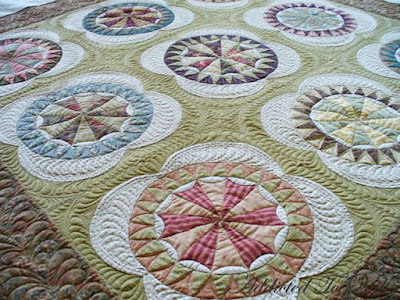Glenna found this top in Edmond, Oklahoma
She thinks the tan was once red and it does
look like that very unstable Congo red introduced about 1880.
She posted photos on our QuiltHistorySouth Facebook page.
Edmond, Oklahoma certainly qualifies as South and this
seemingly unique pattern is actually a Southern regional design.
Here's one a little bit older discovered by the South Carolina
project and pictured in black and white in their book Social Fabric,
made in the town of Woodruff in Spartanburg County.
Laurel Horton and the other people working on the project
years ago thought it might be about 1870---which is late for
a chintz swag border.
But that's another thing they discovered. Quiltmakers in
South Carolina held on to the idea of chintz borders after
the rest of the country moved on.
(I worked a little on the Quilt Index photo)
It's a variation of a popular Southern pattern that goes by the names Wheel of Fortune,
Circle Saw or Wagon Wheel.
with spiraling centers or straight spokes.
Then piece it into a four-lobed or four-petaled shape.
From a post on the QuiltsVintage&Antique Facebook page
The chintz border is optional. No surprise, but this was sold
at a South Carolina auction house Wooten & Wooten.
Once in Candace St.Lawrence's collection.
An outrageously dramatic border.
The light floral at the top looks like a fairly recent patch.
Might be a South Carolina quilt.
Carol Butzge posted one she owns. She bought it from
Jean Lyle who told her it was from Georgia.
with a border of serpentine stripes.
We know quite a bit about this one attributed to Mary Alice Catlett Vance
Buncombe County, North Carolina and dated 1879.
See posts on the Catletts here:
From Lila Laurette Carroll's collection
Michelle Yeo sells a pattern from one very similar to Laurette's. Fewer spokes.
There do seem to be a lot of style conventions in these.
But the lobes or petals are not always white.
Sometimes they are green as in this example from the Tennessee project,
attributed to a Mississippi woman
who pieced her border.
Julie Silber's inventory.
Another convention is the echo quilting around the petals.
Five blocks from an online auction with each of the spokes
chrome orange rather than contrasting colors.
Blue petals from Abbeville County in South Carolina.
Hard to see in the Quilt Index photo.
With an appliqued swag border.
And you could piece a nine-patch into the background
like Lois Wright Jarrel (1871-1954) who seems to have
lived in Oklahoma.
Her quilt recorded by the Arizona project is in the Pinal
County Historical Society.
Another option: Six petals. This tattered Georgia quilt, circa 1900, found inside another quilt and used as batting, attributed to Mary Ann Seagrave Clements (1844-1910) and daughter Ella Dennis in Fulton County where Atlanta is. Newer style conventions, partial blocks on the side and triple strip sashing.
Similar block in similar shape, found in the Michigan project
and called by the family who recalled that it was made by Maria
Ingersoll Snipes (1869-1942) of Atlanta.
And here is Maria in 1910, about the time the block was made,
living in Atlanta with her husband, a blacksmith with the wonderful
name of President Snipes and several children (one of whom is President Jr.)
Southerners are often as creative in naming their children as they are in their quilt patterns.
Beryl's version of Abbeville County, quilted by
Addicted to Quilts
































No comments:
Post a Comment